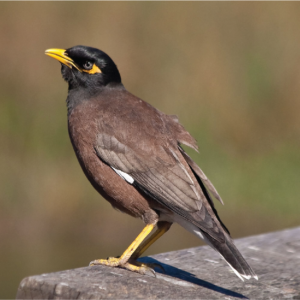Indian Myna

- Distribution: Native to South Asia (India, Pakistan, Bangladesh, Sri Lanka) and widely introduced in other regions.
- Habitat: Urban areas, agricultural land, parks, gardens.
- Diet: Omnivorous, feeding on insects, fruits, seeds, and human food scraps.
- Size: Around 23-25 cm in length.
Native to Asia, the common myna, also known as the Indian myna (Acridotheres tristis), is a member of the Sturnidae family of birds. The common myna is an omnivorous bird of open forest with a strong sense of territoriality that has adapted very well to urban settings.
The exposed yellow patch behind the eye, the black hooded head, and the brown body of the common myna are easily distinguishable features. The legs and bill are a vivid golden color. The underside of the wings has a white wing line, and there is a white patch on the outer primaries. Birds are typically observed in pairs, and the sexes are similar.
The birds make a variety of sounds, such as croaks, squawks, chirps, clicks, whistles, and “growls.” They also frequently fluff their feathers and bob their heads when singing. When a predator is nearby or when it is ready to take off, the common myna will screech warnings to its partner or other birds.
Because of their singing and “speaking” talents, common mynas are commonly kept as cage birds. “Communal noise” is the collective vocalization of common mynas prior to their slumber in communal roosts.
The common myna uses nest boxes with ease and has been observed evicting the chicks of previous nesting partners by holding them in its beak and occasionally not even using the vacated nest boxes. It also uses the nests of woodpeckers, parakeets, and other birds. Its success as an invasive species is partly attributed to its aggressive behavior.
The common myna is an omnivore, just like the majority of starlings. It consumes insects, earthworms, grubs, arachnids, crustaceans, reptiles, small mammals, seeds, grains, fruits, nectar and petals from flowers, and human excrement left over from their lives.
